ADC Telecommunications DLC1902B Digivance® LRCS 1900 MHz, 20-Watt LPA User Manual 75158
ADC Telecommunications Inc Digivance® LRCS 1900 MHz, 20-Watt LPA 75158
Contents
User manual 6
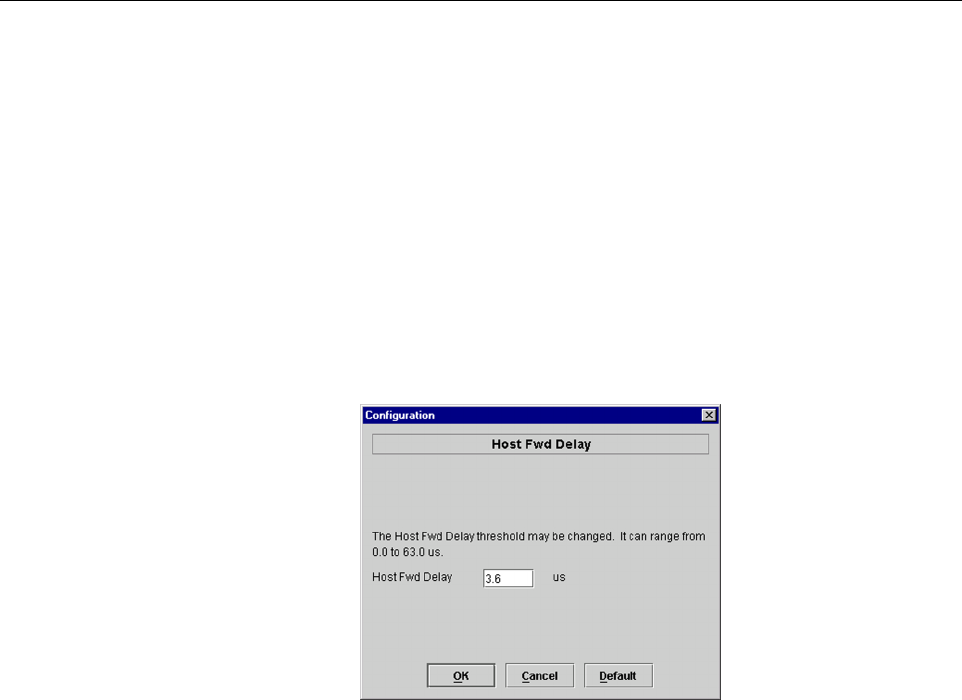
ADCP-75-158 • Issue 1 • July 2003 • Section 4: Operation
Page 4-18
© 2003, ADC Telecommunications, Inc.
2. Right-click on the Host Fwd Delay section of the display (see Figure 4-14). The Host
Fwd Delay pop-up screen will open as shown in Figure 4-15.
3. Obtain the value of the forward delay as specified in the system design plan. The delay is
adjustable in 0.1 µsec steps.
4. Enter the forward path delay value and click OK to close the pop-up screen and to make
the changes take effect.
5. Repeat the process for reverse delay and diversity reverse delay by right-clicking on the
appropriate delay section (see Figure 4-14) and then entering the required delay value in
the pop-up screen.
6. Click OK to close each pop-up screen and to make the changes take effect.
Figure 4-15. Host Fwd Delay Pop-Up Screen

ADCP-75-158 • Issue 1 • July 2003 • Section 5: Maintenance
Page 5-1
© 2003, ADC Telecommunications, Inc.
SECTION 5: MAINTENANCE
1 SYSTEM MAINTENANCE OVERVIEW . . . . . . . . . . . . . . . . . . . . . . . . . . . . . . . . . . . . . . . . . . . . . . . . . . . . . . . . . .5-1
1.1 Tools and Materials . . . . . . . . . . . . . . . . . . . . . . . . . . . . . . . . . . . . . . . . . . . . . . . . . . . . . . . . . . . . . . .5-1
2 FAULT DETECTION AND ALARM REPORTING. . . . . . . . . . . . . . . . . . . . . . . . . . . . . . . . . . . . . . . . . . . . . . . . . . . .5-2
3 FAULT ISOLATION AND TROUBLESHOOTING. . . . . . . . . . . . . . . . . . . . . . . . . . . . . . . . . . . . . . . . . . . . . . . . . . . .5-5
3.1 Host Unit Troubleshooting. . . . . . . . . . . . . . . . . . . . . . . . . . . . . . . . . . . . . . . . . . . . . . . . . . . . . . . . . . .5-6
3.2 STM Troubleshooting . . . . . . . . . . . . . . . . . . . . . . . . . . . . . . . . . . . . . . . . . . . . . . . . . . . . . . . . . . . . . .5-8
3.3 LPA Troubleshooting . . . . . . . . . . . . . . . . . . . . . . . . . . . . . . . . . . . . . . . . . . . . . . . . . . . . . . . . . . . . . 5-10
4 TEST PROCEDURES . . . . . . . . . . . . . . . . . . . . . . . . . . . . . . . . . . . . . . . . . . . . . . . . . . . . . . . . . . . . . . . . . . . . 5-11
4.1 Optical Power Test. . . . . . . . . . . . . . . . . . . . . . . . . . . . . . . . . . . . . . . . . . . . . . . . . . . . . . . . . . . . . . . 5-11
4.2 Optical Loopback Test . . . . . . . . . . . . . . . . . . . . . . . . . . . . . . . . . . . . . . . . . . . . . . . . . . . . . . . . . . . . 5-12
5 MAINTENANCE PROCEDURES . . . . . . . . . . . . . . . . . . . . . . . . . . . . . . . . . . . . . . . . . . . . . . . . . . . . . . . . . . . . . 5-14
5.1 Scheduled Maintenance . . . . . . . . . . . . . . . . . . . . . . . . . . . . . . . . . . . . . . . . . . . . . . . . . . . . . . . . . . . 5-14
5.2 Remote Unit Outdoor Cabinet Filter Cleaning Procedure . . . . . . . . . . . . . . . . . . . . . . . . . . . . . . . . . . . . .5-14
5.3 Host Unit Fan Replacement Procedure . . . . . . . . . . . . . . . . . . . . . . . . . . . . . . . . . . . . . . . . . . . . . . . . . 5-15
5.4 Spectrum Transport Module Fan Replacement Procedure . . . . . . . . . . . . . . . . . . . . . . . . . . . . . . . . . . . . 5-17
5.5 Linear Power Amplifier Fan Replacement Procedure . . . . . . . . . . . . . . . . . . . . . . . . . . . . . . . . . . . . . . .5-19
_________________________________________________________________________________________________________
1 SYSTEM MAINTENANCE OVERVIEW
This section explains the Digivance system fault detection and alarm reporting system, provides
a method for isolating and troubleshooting faults, and provides test and maintenance
procedures. The Digivance system requires minimal regular maintenance to insure continuous
and satisfactory operation. Components that require regular replacement, cleaning, or testing
include the HU and RU fans and the RU outdoor cabinet air-filter.
Maintenance also includes diagnosing and correcting service problems as they occur. When an
alarm is reported, it will be necessary to follow a systematic troubleshooting procedure to locate
the problem. Once the source of the problem is isolated, the appropriate corrective action can be
taken to restore service. The only internal components that can be replaced are the cooling fans
which mount in the HU, RU, and LPA. The failure of any other component within a unit will
require replacement of that unit.
1.1 Tools and Materials
The following tools and materials are required in order to complete the procedures in this
section:
•ESD wrist strap
• IR filtering safety glasses
• Patch cords with SC connectors
• 15 dB in-line SC optical attenuators

ADCP-75-158 • Issue 1 • July 2003 • Section 5: Maintenance
Page 5-2
© 2003, ADC Telecommunications, Inc.
• Optical power meter (1550 and 1310 nm)
• TORX screwdriver (with T10 bit)
2 FAULT DETECTION AND ALARM REPORTING
The Digivance system on-board embedded software detects various unit and system faults and
reports them as either Major or Minor alarms. A Major alarm indicates that the system has
failed in a way that directly affects RF transport performance. This usually means that some
calls or perhaps all calls cannot be made over the system. A Minor alarm means that system
performance is not affected or in some cases, that the performance may no longer be optimal.
Four types of faults cause a minor alarm to be reported: overtemperature, fan failure, diversity
path failure, and an external minor fault (user defined fault). All other faults are reported as a
Major alarm.
Reporting of Major and Minor alarms is accomplished through the HU alarm contacts, the unit
front panel LED’s, the EMS software Graphical User Interface (GUI), and the Network
Operations Center - Network Element Manager (NOC/NEM) interface.
The HU is equipped with a set of both normally open (NO) and normally closed (NC) alarm
contacts which are used to report both Major and Minor alarms to an external alarm system. The
alarm contacts summarize the inputs so that any Major or Minor alarm will trigger an alarm
report to the external alarm system.
The HU, STM, and LPA front panel LED indicators are used to report specific alarms which are
reflected in the LED colors: Green, Red, Yellow, and Off. A description of the Host Unit, Linear
Power Amplifier, and Spectrum Transport Module LED indicators is provided respectively in
Table 5-1, Table 5-2, and Table 5-3.
The EMS software GUI provides both a summary and a more detailed list of alarm information
that includes unit and module level faults, circuit faults, and measured value faults such as
voltages, RF power, and temperature. A summary showing a list of all systems and their current
alarm status is presented through the Alarm OverView display. A detailed list of alarm
information is presented through the HOST alarm display and the REMOTE alarm display. All
the inputs that the system reports as alarms are shown in the HOST and REMOTE alarm
displays.
The NOC/NEM interface provides the same summary and detailed list of alarm information as
the EMS software GUI but in an ASCII text string format. Sending the command GET ALARM
SUMMARY produces a list of all systems and their current alarm status. Sending the command
GET ALARM ALL for a specific system will produce a detailed list of alarm information for
the specified system.

ADCP-75-158 • Issue 1 • July 2003 • Section 5: Maintenance
Page 5-3
© 2003, ADC Telecommunications, Inc.
Table 5-1. Host Unit LED Indicators
INDICATOR COLOR DESCRIPTION
POWER
Green
Off
Indicates if the HU is powered or un-powered.
The DC power source is on.
The DC power source is off.
STANDBY
Green (blinking)
Yellow (blinking)
Red (blinking)
Off
Indicates if the system is in the standby, normal, test, or
program load mode.
The HU is in the standby mode.
The HU is in the program load mode.
The HU is in the test mode.
The HU is in the normal mode.
HOST UNIT
Green
Yellow
Red
Indicates if the HU is normal, over temperature, or if a
fault is detected.
The HU is normal.
High temperature detected in HU.
Fault detected by the HU or HU/RU band mismatch.
REMOTE UNIT
Green
Yellow
Red
Indicates if an alarm is detected at the RU.
No alarms detected at the RU.
A minor alarm is detected at the RU.
A major alarm is detected at the RU.
DRIVE
Green
Yellow
Red
Indicates if the forward path RF signal level is normal,
above overdrive threshold, or below underdrive threshold.
The RF signal level is normal
The RF signal level is below the underdrive threshold.
The RF signal level is above the overdrive threshold.
PORT 1/PORT 2
Green
Red
Indicates if the reverse/forward path optical signals from
the STM/HU are normal, if errors are detected, or if the
optical signal is not detected.
The reverse/forward path optical signal is normal.
Excessive errors (see Note) are detected in the reverse or for-
ward path optical signals or the HU or STM is not receiving a
forward or reverse path optical signal.
Note: Excessive errors mean the Bit Error Rate (BER) has exceeded 10–6 (1 bit error per million bits)
Table 5-2. Linear Power Amplifier LED Indicator
INDICATOR COLOR DESCRIPTION
STATUS
Green (blinking)
Green
Yellow (blinking)
Yellow
Red
Indicates the operational state of the LPA and whether or
not any faults are detected.
The LPA is in the normal state.
The LPA is in a forced shutdown state, no faults detected.
The LPA is in the normal state, minor fault detected.
The LPA is initializing.
The LPA is in an internal shutdown state, major fault detected.

ADCP-75-158 • Issue 1 • July 2003 • Section 5: Maintenance
Page 5-4
© 2003, ADC Telecommunications, Inc.
Table 5-3. Spectrum Transport Module LED Indicators
INDICATOR COLOR DESCRIPTION
AC POWER
Green
Red
Indicates if the STM is powered by the AC power source or
the back-up battery system.
The STM is powered by the AC power source.
The STM is powered by the back-up battery system.
STANDBY
Green (blinking)
Yellow (blinking)
Red (blinking)
Off
Indicates if the system is in the standby, normal, test, or
program load mode.
The STM is in the standby mode.
The STM is in the program load mode.
The STM is in the test mode.
The STM is in the normal mode.
HOST UNIT
Green
Yellow
Red
Indicates if an alarm is detected at the HU.
No alarms detected at the HU.
A minor alarm is detected at the HU.
A major alarm is detected at the HU.
STM
Green
Yellow
Red
Indicates if the STM is normal, over temperature, or if a
fault is detected.
The STM is normal.
The STM is over temperature due to high ambient temperature
or the fan has failed.
Fault detected by the STM or HU/RU band mismatch.
PA
Green
Yellow
Red
Indicates if the LPA is normal, over temperature, has a fan
failure, or is faulty.
The LPA is normal.
The LPA is over temperature or the fan has failed.
Internal fault detected in the LPA.
VSWR
Green
Red
Indicates if the forward path VSWR is above or below the
threshold.
The VSWR is below the threshold.
The VSWR is above the threshold.
PORT 1/PORT 2
Green
Red
Indicates if the forward/reverse path optical signals from
the HU/STM are normal, if errors are detected, or if the
optical signal is not detected.
The forward/reverse path optical signal is normal.
Excessive errors (see Note) are detected in the forward or
reverse path optical signals or the STM or HU is not receiving
a forward or reverse path optical signal.
Note: Excessive errors mean the Bit Error Rate (BER) has exceeded 10–6 (1 bit error per million bits)

ADCP-75-158 • Issue 1 • July 2003 • Section 5: Maintenance
Page 5-5
© 2003, ADC Telecommunications, Inc.
3 FAULT ISOLATION AND TROUBLESHOOTING
Alarm information may be accessed and faults isolated using the information provided by the
unit front panel LED indicators, the EMS software GUI alarm displays, or the NOC-EMS
interface. Because the alarm information provided by the EMS GUI and the NOC-EMS
interface is very detailed, refer to Table 5-4, Table 5-5, or Table 5-6 to determine the unit LED
indicator (Host Unit, Remote Unit, or LPA) that corresponds to the indicated alarm. Then refer
to Table 5-7, Table 5-8, or Table 5-9 to identify the problem, check out the possible causes, and
take corrective action.
Table 5-4. Host Unit Major and Minor Alarms
MAJOR ALARM LED INDICATOR MAJOR ALARM LED INDICATOR
Operating Mode STANDBY Fwd Synth Lock HOST UNIT
8 Volt HOST UNIT RF Mute (Does not apply)
Pri No Light PORT 1/PORT 2 Major Extern Output (Does not apply)
Pri Fwd Mux Lock HOST UNIT Companion Lost (Does not apply)
Pri Rev Synth Lock HOST UNIT MINOR ALARMS LED INDICATOR
Overdrive DRIVE Temperature HOST UNIT
Unit Mismatch HOST UNIT Sec No Light (Does not apply)
Link Alarm (Does not apply) Sec Errors (Does not apply)
3.8 Volt HOST UNIT Sec Rev Synth Lock (Does not apply)
Pri Laser Fail HOST UNIT Underdrive DRIVE
Pri Errors PORT 1/PORT 2 Minor Extern Output (Does not apply)
Table 5-5. Remote Unit Major Alarms
MAJOR ALARM LED INDICATOR MAJOR ALARM LED INDICATOR
Operating Mode STANDBY Battery Voltage (Does not apply)
3.8 Volt STM Pri Laser Fail STM
Pri Errors PORT 1/PORT 2 Fwd Synth Lock STM
Reference Synth Lock STM System VSWR VSWR
LPA DC Fail PA LPA Low Power PA
LPA VSWR PA Unit Mismatch STM
Link Alarm (Does not apply) Converter STM
AC Fail AC POWER Pri No Light PORT 1/PORT 2
8 Volt STM Pri Rev Synth Lock STM
Pri Rev Mux Lock STM LPA Detect PA
RF Mute (Does not apply) LPA Over Power PA
LPA Loop Failed PA Companion Lost (Does not apply)
Major Extern Alarm Inp (Does not apply) – –
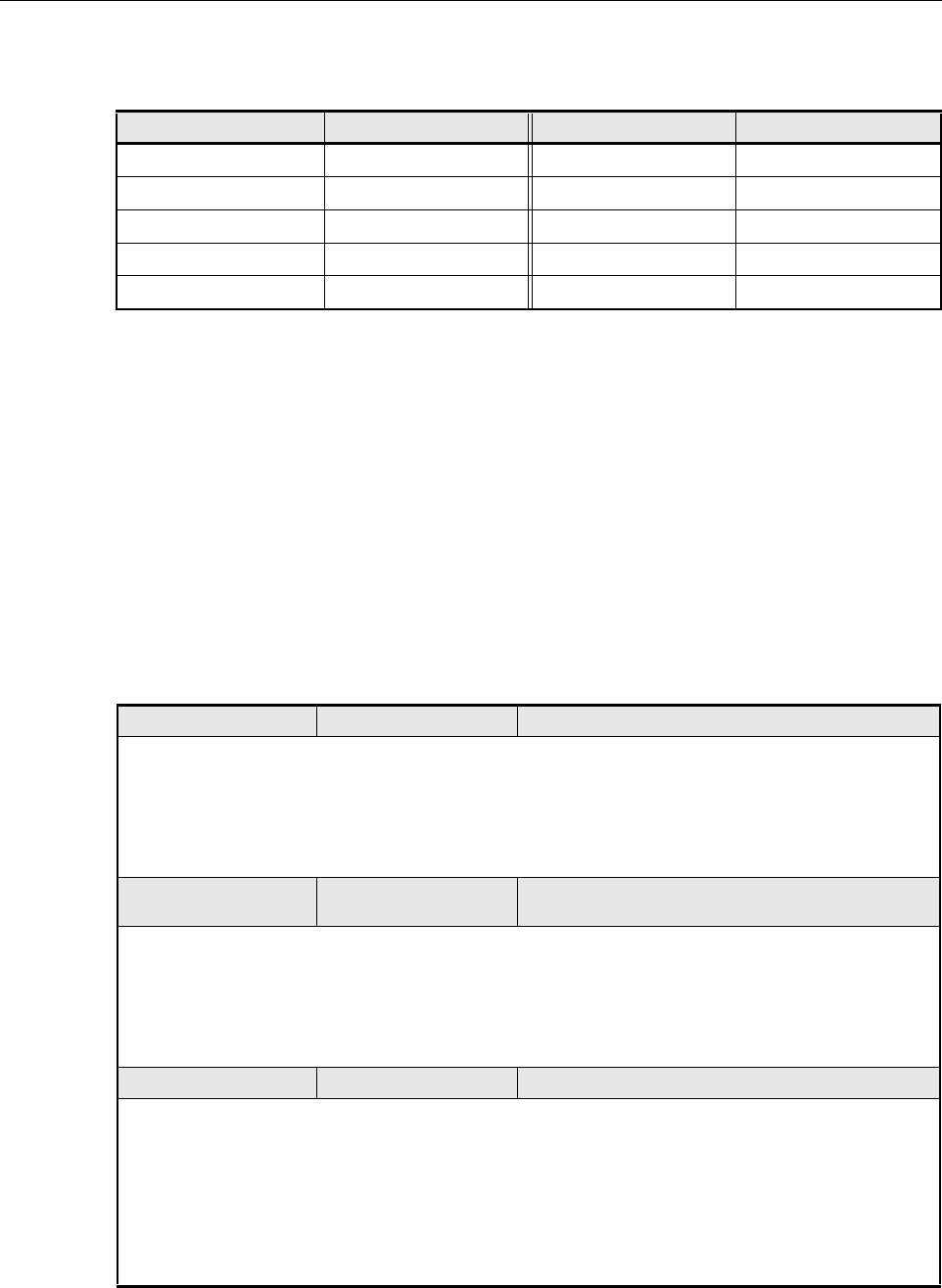
ADCP-75-158 • Issue 1 • July 2003 • Section 5: Maintenance
Page 5-6
© 2003, ADC Telecommunications, Inc.
3.1 Host Unit Troubleshooting
During normal HU operation, all LED’s should be green except the STANDBY LED which
should be Off. When a Minor alarm occurs, one or more of the LED’s will turn yellow. When a
Major alarm occurs, one or more of the LED’s will turn red.
It is recommended that whenever there are multiple alarms, the optical alarms should be
checked and cleared first. Because the host and remote units function as a system, a fault in the
fiber optic link will cause various unit alarms to be reported.
Table 5-6. Remote Unit Minor Alarms
MINOR ALARM LED INDICATOR MINOR ALARM LED INDICATOR
Temperature STM Sec Laser Fail (Does not apply)
Sec Rev Mux Lock (Does not apply) Sec Rev Synth Lock (Does not apply)
Rev Path Level (Does not apply) LPA Disable STATUS (LPA)
LPA Fan PA LPA High Temp PA
Minor Extern Alarm Inp (Does not apply) RF Out Very Low (Does not apply)
Table 5-7. Host Unit Fault Isolation and Troubleshooting
LED: POWER Color: Off Alarm Type: Major
PROBLEM: The HU is not powered.
POSSIBLE CAUSE CORRECTIVE ACTION/COMMENTS
1. The fuse is open or removed from the fuse
panel. 1. Replace or reinstall fuse at fuse panel.
LED: STANDBY Color: Green (blinking) or
Yellow (blinking)
Alarm Type: None
PROBLEM: The HU is out of service.
POSSIBLE CAUSE CORRECTIVE ACTION/COMMENTS
1. The HU is in the standby (green) or program
load (yellow) mode. 1. Use EMS to place the HU in the normal (off)
mode.
LED: HOST UNIT Color: Yellow Alarm Type: Minor
PROBLEM: The HU is overheating.
POSSIBLE CAUSE CORRECTIVE ACTION/COMMENTS
1. Air intake or exhaust opening to HU chassis
is blocked
2. Ambient temperature > 50º C/122º F.
3. Faulty fan.
1. Remove cause of air-flow blockage.
2. Reduce ambient temperature.
3. Replace HU fan (See Section 5.3).
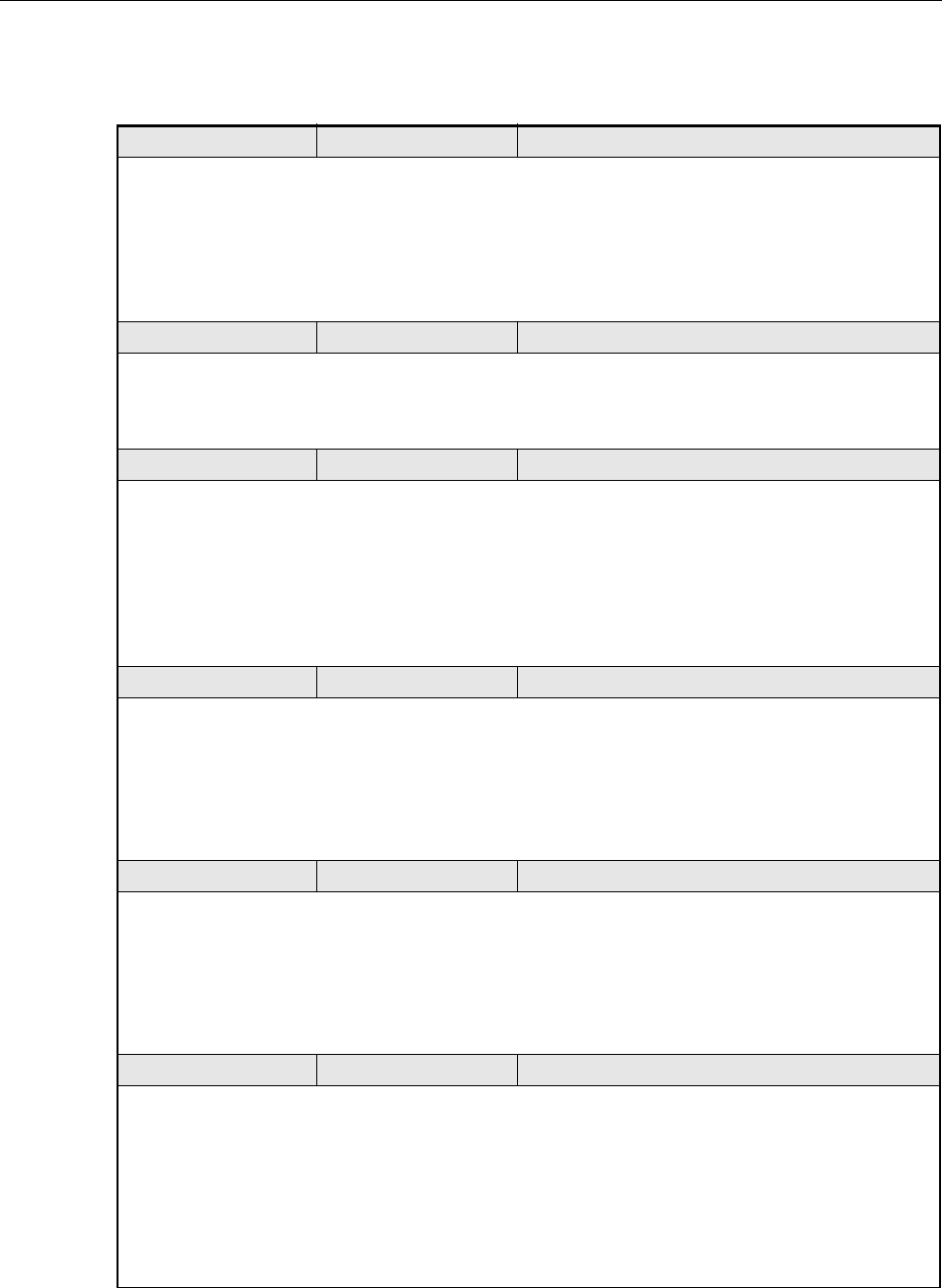
ADCP-75-158 • Issue 1 • July 2003 • Section 5: Maintenance
Page 5-7
© 2003, ADC Telecommunications, Inc.
LED: HOST UNIT Color: Red Alarm Type: Major
PROBLEM: A major alarm fault detected by HU.
POSSIBLE CAUSE CORRECTIVE ACTION/COMMENTS
1. Fiber optic link fault.
2. HU and STM band mismatch.
3. The HU has failed.
1. Follow procedure specified when the PORT 1/
PORT 2 LED is red.
2. Replace HU or STM with correct unit.
3. Replace the HU.
LED: REMOTE UNIT Color: Yellow Alarm Type: Minor
PROBLEM: A minor alarm fault is detected at the RU.
POSSIBLE CAUSE CORRECTIVE ACTION/COMMENTS
1. The STM or LPA is overheating. 1. Check RU LED indicators and refer to Table 5-8
LED: REMOTE UNIT Color: Red Alarm Type: Major
PROBLEM: A major alarm fault is detected at the RU.
POSSIBLE CAUSE CORRECTIVE ACTION/COMMENTS
1. Fiber optic link fault.
2. AC power failure at RU.
3. High VSWR.
4. The RU cabinet door is open or the STM or
LPA has failed.
1. Check RU LED indicators and refer to Table 5-8.
2. Check RU LED indicators and refer to Table 5-8.
3. Check RU LED indicators and refer to Table 5-8.
4. Check RU LED indicators and refer to Table 5-8.
LED: DRIVE Color: Yellow Alarm Type: Minor
PROBLEM: The RF input signal level is below the underdrive threshold.
POSSIBLE CAUSE CORRECTIVE ACTION/COMMENTS
1. Faulty BTS or faulty coaxial connection
between the HU and the BTS.
2. Incorrect attenuation in forward path RF coax-
ial link.
1. Check forward path signal level at the HU.
2. Check Host Forward Attenuator setting and
adjust if attenuation is too high.
LED: DRIVE Color: Red Alarm Type: None
PROBLEM: The RF signal is above the overdrive threshold.
POSSIBLE CAUSE CORRECTIVE ACTION/COMMENTS
1. Composite output signal level from BTS is too
high.
2. Incorrect attenuation in forward path RF
coaxial link.
1. Check BTS composite output signal level and
adjust if too high.
2. Check Forward Attenuator setting and adjust if
attenuation is too low.
LED: PORT 1/PORT 2 Color: Red Alarm Type: Major
PROBLEM: Excessive errors are detected in the reverse or forward path optical signal or no forward or reverse
path optical signal is detected.
POSSIBLE CAUSE CORRECTIVE ACTION/COMMENTS
1. Faulty reverse or forward path optical fiber.
2. Faulty optical transmit port at the STM or
HU; or faulty optical receive port at the STM
or HU.
1. Test optical fiber. Clean connector if dirty. Repair
or replace optical fiber if faulty. (See Section 4.1).
2. Test optical ports. Replace HU or STM if port is
faulty (See Section 4.2).
Table 5-7. Host Unit Fault Isolation and Troubleshooting, continued
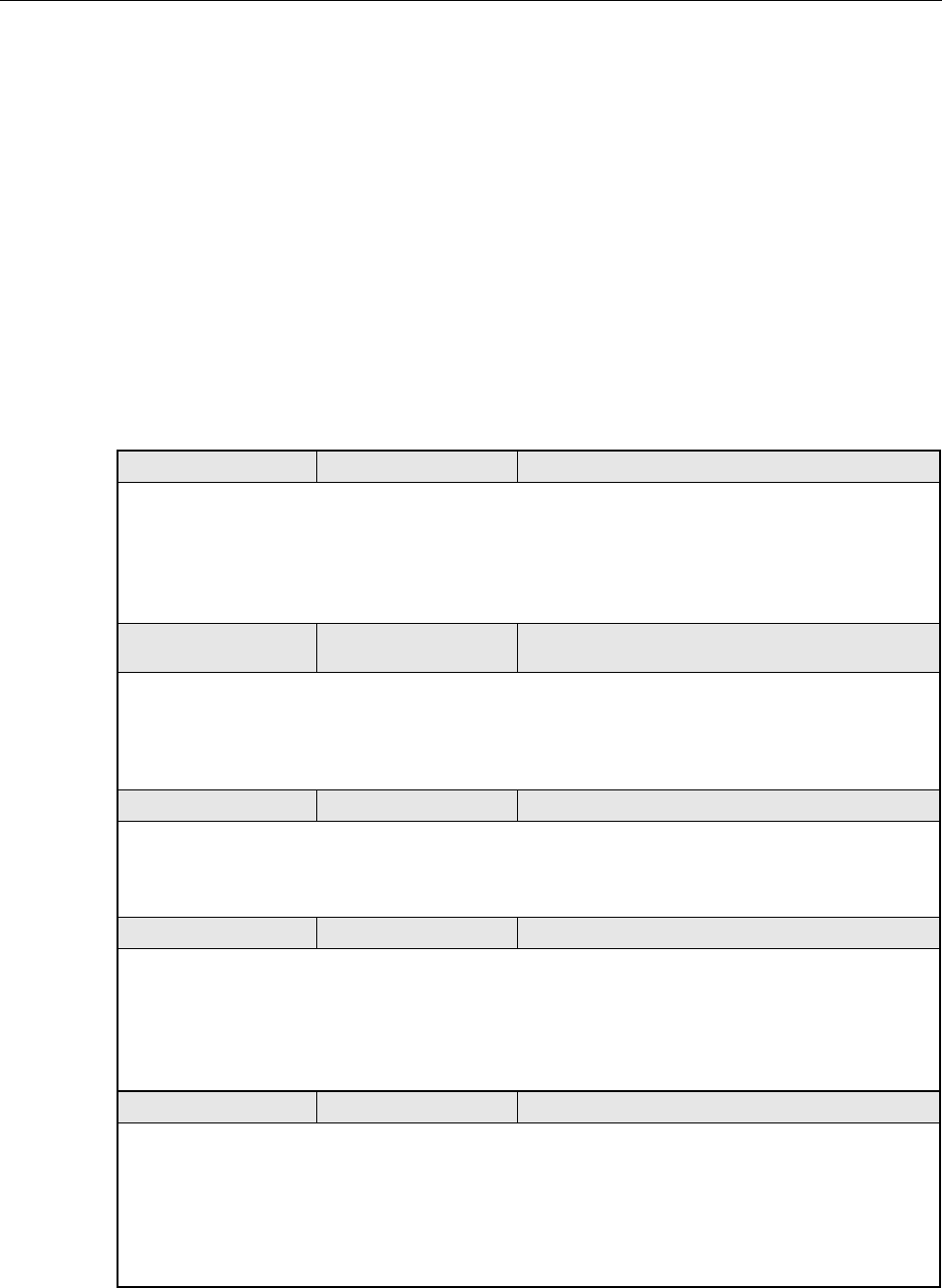
ADCP-75-158 • Issue 1 • July 2003 • Section 5: Maintenance
Page 5-8
© 2003, ADC Telecommunications, Inc.
3.2 STM Troubleshooting
During normal STM operation, all LED’s should be green except the STANDBY LED which
should be Off. When a Minor alarm occurs, one or more of the LED’s will turn yellow. When a
Major alarm occurs, one or more of the LED’s will turn red.
It is recommended that whenever there are multiple alarms, the optical alarms should be
checked and cleared first. Because the host and remote units function as a system, a fault in the
fiber optic link will cause various unit alarms to be reported.
Table 5-8. STM Fault Isolation and Troubleshooting
LED: AC POWER Color: Off Alarm Type: Major
PROBLEM: The RU is powered by the battery back-up system.
POSSIBLE CAUSE CORRECTIVE ACTION/COMMENTS
1. The AC power system circuit breaker is open
or the AC power has failed.
2. The STM has failed.
1. Check the AC power system, repair as needed,
and reset circuit breaker.
2. Replace the STM.
LED: STANDBY Color: Green (blinking) or
Yellow (blinking)
Alarm Type: None
PROBLEM: The RU is out of service.
POSSIBLE CAUSE CORRECTIVE ACTION/COMMENTS
1. The RU is in the standby (green) or program
load (yellow) mode. 1. Use EMS to place the RU in the normal (off)
mode.
LED: HOST UNIT Color: Yellow Alarm Type: Minor
Problem: A minor alarm fault is detected at the HU.
POSSIBLE CAUSE CORRECTIVE ACTION/COMMENTS
1. The HU is overheating. 1. Check HU LED indicators and refer to Table 5-7
LED: HOST UNIT Color: Red Alarm Type: Major
PROBLEM: A major alarm fault is detected at the HU.
POSSIBLE CAUSE CORRECTIVE ACTION/COMMENTS
1. Fiber optic link fault.
2. The HU is not powered.
3. The HU has failed.
1. Check HU LED indicators and refer to Table 5-7.
2. Check HU LED indicators and refer to Table 5-7.
3. Check HU LED indicators and refer to Table 5-7.
LED: STM Color: Yellow Alarm: Minor
PROBLEM: The STM is overheating.
POSSIBLE CAUSE CORRECTIVE ACTION/COMMENTS
1. Air intake or exhaust opening to the remote
unit cabinet is blocked
2. Ambient temperature > 50º C/122º F.
3. Faulty fan.
1. Remove cause of air-flow blockage.
2. Reduce ambient temperature.
3. Replace STM fan (See Section 5.4).
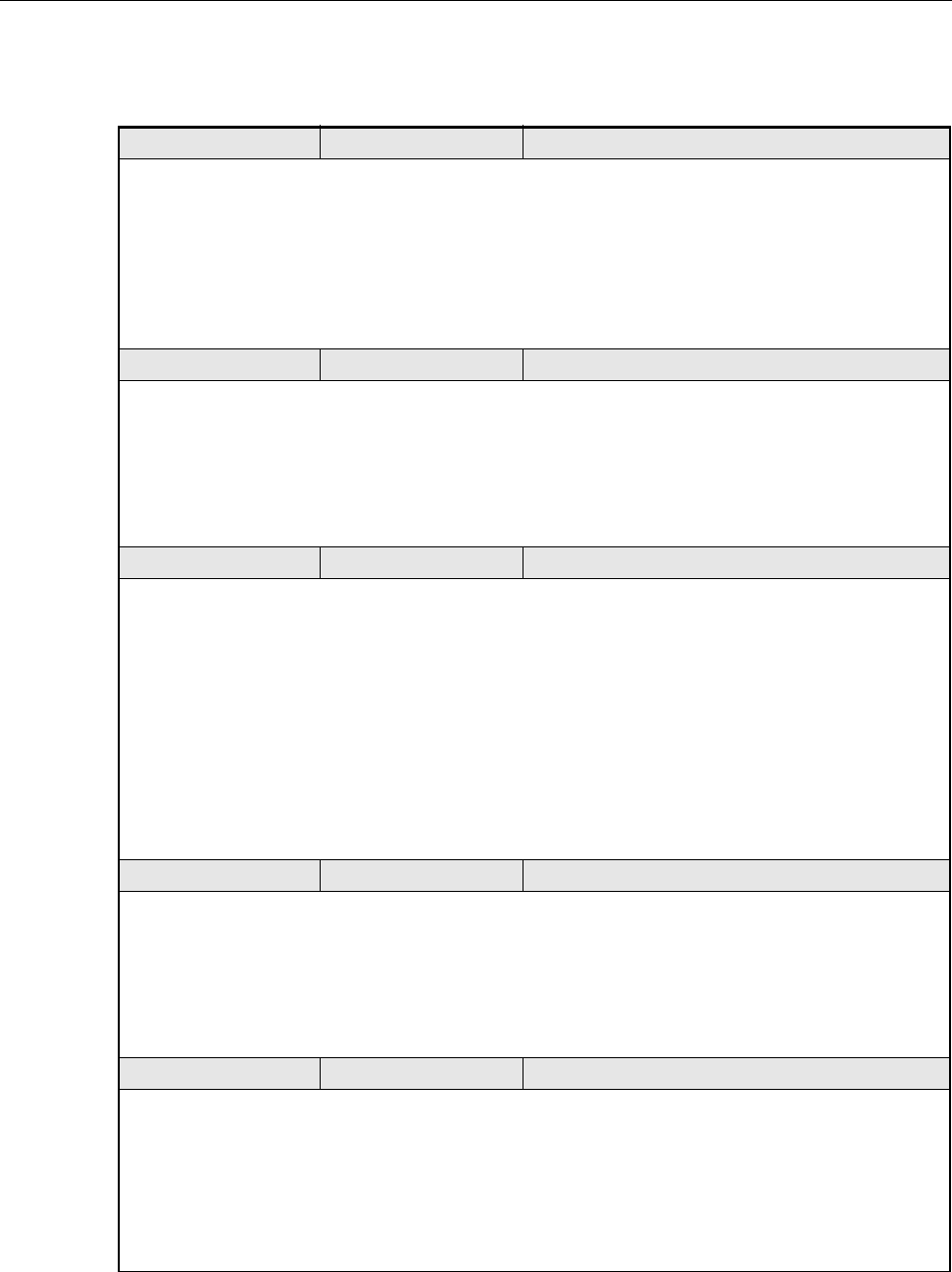
ADCP-75-158 • Issue 1 • July 2003 • Section 5: Maintenance
Page 5-9
© 2003, ADC Telecommunications, Inc.
LED: STM Color: Red Alarm Type: Major
PROBLEM: A major alarm fault detected by the STM.
POSSIBLE CAUSE CORRECTIVE ACTION/COMMENTS
1. Fiber optic link fault.
2. The HU is not powered.
3. HU and STM band mismatch.
4. The STM has failed.
1. Follow procedure specified when the PORT 1/
PORT 2 LED is red.
2. Check HU LED indicators and refer to Table 5-7
3. Replace HU or STM with correct unit.
4. Replace the STM.
LED: PA Color: Yellow Alarm Type: Minor
PROBLEM: The LPA is overheating.
POSSIBLE CAUSE CORRECTIVE ACTION/COMMENTS
1. Air intake or exhaust opening to the remote
unit cabinet is blocked
2. Ambient temperature > 50º C/122º F.
3. Faulty LPA fan.
1. Remove cause of air-flow blockage.
2. Reduce ambient temperature.
3. Replace LPA fan (See Section 5.5).
LED: PA Color: Red Alarm Type: Major
PROBLEM: The LPA in not detected, the RF power is low or not present, or the LPA detects a major alarm.
POSSIBLE CAUSE CORRECTIVE ACTION/COMMENTS
1. The LPA is not present.
2. The LPA RF output is turned off.
3. The forward path RF cables or connectors are
faulty.
4. The LPA is in the forced shutdown state.
5. The LPA is losing gain due to an internal fault.
6. The STM duplexer has failed.
1. Install LPA.
2. Place LPA MUTE/NORM/RESET switch in the
NORM position.
3. Inspect cables and connectors and repair or
replace if faulty.
4. Check LPA display for messages and then refer to
Table 5-9. Replace the LPA if it is faulty.
5. Replace LPA.
6. Replace the STM.
LED: VSWR Color: Red Alarm Type: Major
PROBLEM: The forward path VSWR is above the threshold.
POSSIBLE CAUSE CORRECTIVE ACTION/COMMENTS
1. Faulty antenna or antenna system.
2. Faulty antenna cable.
3. The STM has failed.
1. Check the antenna circuit for shorts or opens
(including lightning protector).
2. Check the antenna cable for faulty connections.
3. Replace the STM.
LED: PORT 1/PORT 2 Color: Red Alarm Type: Major
PROBLEM: Excessive errors are detected in the reverse or forward path optical signal or no forward or reverse
path optical signal is detected.
POSSIBLE CAUSE CORRECTIVE ACTION/COMMENTS
1. Faulty forward or reverse path optical fiber.
2. Faulty optical transmit port at the HU or
STM; or faulty optical receive port at the HU
or STM.
1. Test optical fiber. Clean connector if dirty. Repair
or replace optical fiber if faulty. (See Section 4.1).
2. Test optical ports. Replace HU or STM if port is
faulty (See Section 4.2).
Table 5-8. STM Fault Isolation and Troubleshooting, continued
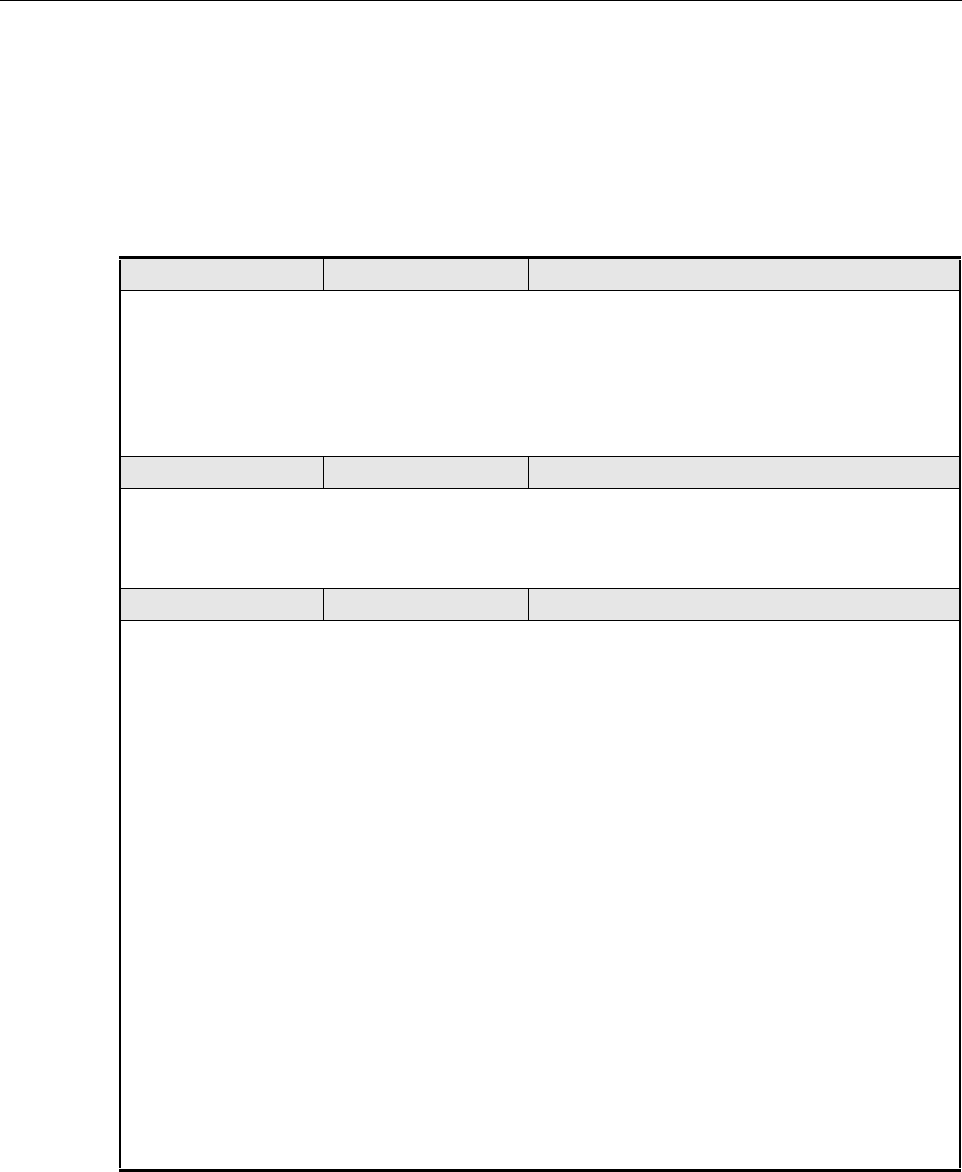
ADCP-75-158 • Issue 1 • July 2003 • Section 5: Maintenance
Page 5-10
© 2003, ADC Telecommunications, Inc.
3.3 LPA Troubleshooting
During normal LPA operation, the STATUS LED should be blinking green (normal operation)
or blinking yellow (minor fault).
Table 5-9. LPA Fault Isolation and Troubleshooting
LED: STATUS Color: Green Alarm Type: None
PROBLEM: The LPA is in the forced shutdown state.
POSSIBLE CAUSES
1.The MUTE/NORM/RESET switch is in the
MUTE position.
2. The Digivance system is in the STANDBY
mode.
1. Place MUTE/NORM/RESET switch in the
NORM position.
2. Use EMS to change Digivance system from
standby mode to the normal mode.
LED: STATUS Color: Yellow (blinking) Alarm Type: Minor
PROBLEM: The LPA detects a minor fault.
POSSIBLE CAUSE CORRECTIVE ACTION/COMMENTS
1. The LPA fan has failed but unit not overheated. 1. Replace LPA fan. (see Section 5.5)
LED: STATUS Color: Red Alarm Type: Major
PROBLEM: The LPA is in the internal shutdown state.
POSSIBLE CAUSE CORRECTIVE ACTION/COMMENTS
1. The interface cable between the LPA and STM
is faulty, the antenna cable is faulty, the
antenna or antenna system is faulty, or the
STM duplexer is faulty (VSWR alarm).
2. The power level of the RF forward path
composite input signal at the HU is too high.
(Over power alarm)
3 The LPA fan has failed and unit has
overheated. (High temp alarm)
4. Air intake or exhaust opening to RU outdoor
cabinet is blocked causing unit to overheat.
(High temp alarm)
5. RU ambient temperature > 50º C/122º F. (High
temp alarm)
6. The LPA is faulty. (VSWR, DC fail, Loop fail,
or low power alarm)
1. Inspect cable, antenna, and connectors and repair
or replace if faulty. Replace STM if duplexer is
faulty. To reset, use EMS to place Digivance
system in standby mode and then place system
back in normal mode.
2. Check the power level of the RF composite input
signal at the HU and adjust to correct level. To
reset, use EMS to place Digivance system in
standby mode and then place system back in
normal mode.
3. Replace LPA fan. (see Section 5.5). To reset, use
EMS to place Digivance system in standby mode
and then place system back in normal mode.
4. Remove cause of air-flow blockage. To reset, use
EMS to place Digivance system in standby mode
and then place system back in normal mode.
5. Reduce RU ambient temperature. To reset, use
EMS to place Digivance system in standby mode
and then place system back in normal mode.
6. Replace LPA.
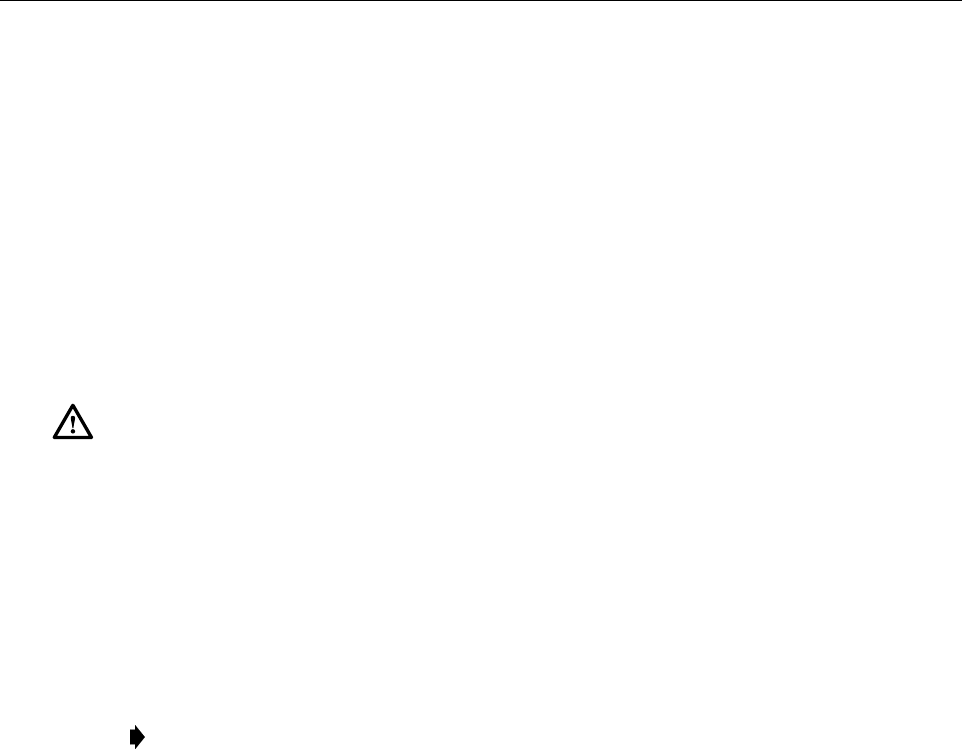
ADCP-75-158 • Issue 1 • July 2003 • Section 5: Maintenance
Page 5-11
© 2003, ADC Telecommunications, Inc.
4 TEST PROCEDURES
This section provides procedures for common troubleshooting and maintenance tests. Refer to
these procedures as needed when specified in the Fault Isolation and Troubleshooting tables in
Section 3.
4.1 Optical Power Test
A break in an optical fiber or a fault with the optical connector will interrupt communications
between linked components or generate excessive errors. Use the following procedure to isolate
a problem with an optical fiber or connector.
1. Put on the IR filtering safety glasses.
2. Notify the NOC or alarm monitoring system operator that the system is going offline.
3. At the HU and at the STM, place the On/Off switches in the OFF position (press O).
4. Disconnect the optical fiber connectors for the fiber to be tested at the HU and the STM.
5. Inspect the optical connectors. Verify that connectors are clean and that no scratches or
imperfections are visible on the fiber end. Clean and polish the optical connectors if necessary.
6. Connect the optical power meter to the output (receiver) end of the optical fiber. If an
attenuator was included in the fiber link, make sure the attenuator is installed.
7. Connect the input (transmitter) end of the optical fiber to the far end HU or STM.
8. At the far end HU or STM, place the On/Off switch in the ON position (press I).
9. Using the far end HU or STM as an optical light source, measure the optical power at the
near end of the optical fiber. The power level of the optical input signal at the HU or STM
must fall within the following ranges:
STM Forward Path Input Signal (Port 1): –15 to –25 dBm (with attenuator installed)
HU Reverse Path Input Signal (Port 2): –15 to –23 dBm (with attenuator installed)
If the power level of the received optical signal is within the specified range, the optical
fiber and the far end unit are good. If the power level of the received signal is not with
the specified range, either the optical fiber is faulty or the far end unit optical transmitter
is faulty. Continue with test procedure to isolate the problem
Danger: This equipment uses a Class 1 Laser according to FDA/CDRH rules. Laser radiation
can seriously damage the retina of the eye. Do not look into the ends of any optical fiber. Do not
look directly into the optical transmitter of any unit or exposure to laser radiation may result.
An optical power meter should be used to verify active fibers. A protective cap or hood MUST
be immediately placed over any radiating transmitter or optical fiber connector to avoid the
potential of dangerous amounts of radiation exposure. This practice also prevents dirt particles
from entering the connector.
Note: Turning off the HU and STM disables the respective lasers which is necessary in
order to safely inspect and clean the optical connectors.
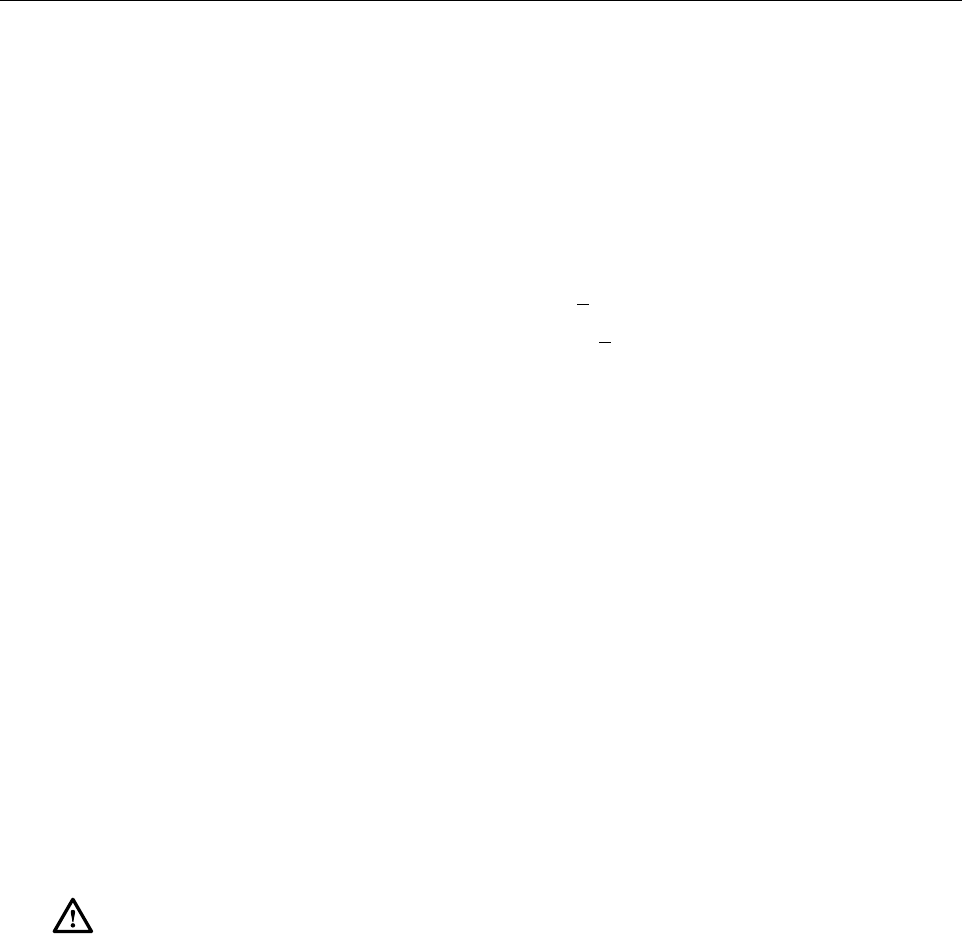
ADCP-75-158 • Issue 1 • July 2003 • Section 5: Maintenance
Page 5-12
© 2003, ADC Telecommunications, Inc.
10. At the far end HU or STM, place the On/Off switch in the OFF position (press O).
11. Disconnect the optical power meter from the near end of the optical fiber.
12. Connect the optical power meter to the far end HU (Port 1) or STM (Port 2).
13. At the far end HU or STM, place the On/Off switch in the ON position (press I).
14. Measure the optical output power of the far end HU or STM. The power level of the
optical output signal from the HU or STM must meet the following specification:
HU Forward Path Output Signal (Port 1): 0 + 1 dBm
STM Reverse Path Output Signal (Port 2): +2 + 1 dBm
If the power level of the optical output signal is within specifications, the optical fiber is
faulty. If the power level of the optical signal is not within specifications, the far end
HU or STM optical transmitter is faulty.
15. At the far end HU or STM, place the On/Off switch in the OFF position (press O).
16. Disconnect the optical power meter from the far end HU or STM.
17. Reconnect the optical fibers at the HU and the STM.
18. Repeat steps 3 through 17 for each optical fiber that requires testing.
19. When ready to put the system back into service, place the On/Off switch in the ON
position (press I) at both the HU and STM.
20. Notify the NOC or alarm monitoring service that the system is going back online.
4.2 Optical Loopback Test
The following procedures provide tests to determine if an optical port fault exists with the Host
Unit or with the STM.
4.2.1 Host Loopback Test
1. Put on the IR filtering safety glasses.
2. Notify the NOC or alarm monitoring system operator that the system is going offline.
3. At the HU, place the On/Off switch in the OFF position (press O).
4. Disconnect the optical fiber connectors from the PORT 1 and PORT 2 optical ports and
place a dust cap over each connector.
Danger: This equipment uses a Class 1 Laser according to FDA/CDRH rules. Laser radiation
can seriously damage the retina of the eye. Do not look into the ends of any optical fiber. Do not
look directly into the optical transmitter of any unit or exposure to laser radiation may result.
An optical power meter should be used to verify active fibers. A protective cap or hood MUST
be immediately placed over any radiating transmitter or optical fiber connector to avoid the
potential of dangerous amounts of radiation exposure. This practice also prevents dirt particles
from entering the connector.

ADCP-75-158 • Issue 1 • July 2003 • Section 5: Maintenance
Page 5-13
© 2003, ADC Telecommunications, Inc.
5. Plug a 15 dB in-line optical attenuator into the PORT 1 optical port.
6. Connect a patch cord between the optical attenuator and the PORT 2 optical port.
7. Place the On/Off switch in the ON position (press I) and observe the PORT 1/PORT 2
LED indicator.
8. The PORT 1/PORT 2 LED indicator will turn either red or green. If the LED turns red,
either the PORT 1 optical transmitter or the PORT 2 receiver is faulty. If the LED turns
green, both PORT 1 and PORT 2 optical ports are good.
9. Place the On/Off switch in the OFF position (press O).
10. Remove the dust caps from the optical fiber connectors.
11. Clean each connector (follow connector supplier’s recommendations) and then insert each
connector into the appropriate optical port.
12. When ready to put the unit back into service, place the On/Off switch in the ON position
(press I).
13. Notify the NOC or alarm monitoring service that the system is going back online.
4.2.2 STM Loopback Test
1. Put on the IR filtering safety glasses.
2. Notify the NOC or alarm monitoring system operator that the system is going offline.
3. At the STM, place the On/Off switch in the OFF position (press O).
4. Disconnect the optical fiber connectors from the PORT 1 and PORT 2 optical ports and
place a dust cap over each connector.
5. Plug a 15 dB in-line optical attenuator into the PORT 1 optical port.
6. Connect a patch cord between the optical attenuator and the PORT 2 optical port.
7. Place the On/Off switch in the ON position (press I) and observe the PORT 1/PORT2 LED
indicator.
8. The PORT 1/PORT 2 LED indicator will turn either red or green. If the LED turns red,
either the PORT 1 receiver is faulty or the PORT 2 transmitter is faulty. If the LED turns
green, both PORT 1 and PORT 2 optical ports are good.
9. Place the On/Off switch in the OFF position (press O).
10. Remove the dust caps from the optical fiber connectors.
11. Clean each connector (follow connector supplier’s recommendations) and then insert each
connector into the appropriate optical port.
12. When ready to put the unit back into service, place the On/Off switch in the ON position
(press I).
13. Notify the NOC or alarm monitoring service that the system is going back online.
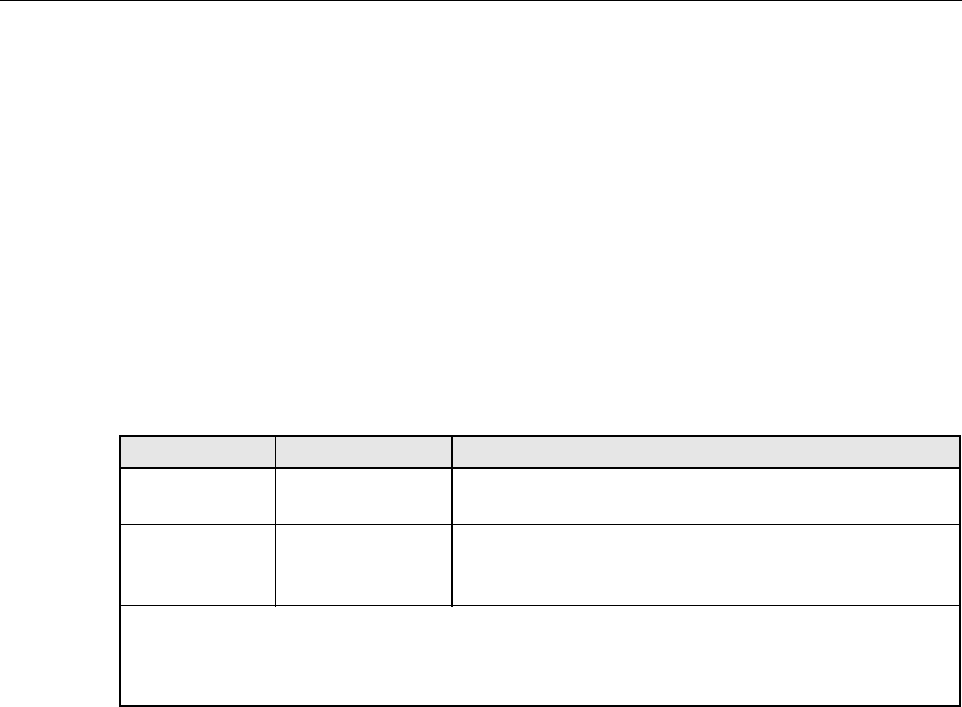
ADCP-75-158 • Issue 1 • July 2003 • Section 5: Maintenance
Page 5-14
© 2003, ADC Telecommunications, Inc.
5 MAINTENANCE PROCEDURES
This section specifies the system maintenance requirements and provides the procedures for the
required maintenance tasks. Refer to these procedures as needed when specified in the
Scheduled Maintenance table.
5.1 Scheduled Maintenance
Table 5-10 lists the items that require regular maintenance and the recommended maintenance
interval. Refer to the section specified in the table for the required maintenance or test
procedure.
5.2 Remote Unit Outdoor Cabinet Filter Cleaning Procedure
The RU outdoor cabinet filter cleans the RU intake air before it enters the cabinet. The filter
should be cleaned approximately once per year and more often in extremely dirty environments.
If the cabinet temperature gradually rises over a long period of time and there are no fan
failures, it is possible that the filter is dirty and requires cleaning. Use the following procedure
to clean the outdoor cabinet filter:
1. Open the RU outdoor cabinet door.
2. Loosen the two set screws that secure the filter to the bottom of the outdoor cabinet as
shown in Figure 5-1.
3. Pull the filter out and away from the bottom of the cabinet. Be careful not to damage the
foam strip that provides the air seal.
4. Gently tap the filter against your hand to dislodge any dirt or dust. If necessary, use
compressed air or a vacuum cleaner to remove dirt.
5. Carefully inspect the filter for holes or tears and replace it if damaged.
6. Orient the filter so the foam sealing strip is facing downward and then re-install the filter
in the filter mounting slot (see Figure 5-1) at the bottom of the cabinet.
7. Re-tighten the two set screws to secure the filter to cabinet
8. Close the RU outdoor cabinet door.
Table 5-10. Scheduled Maintenance
INTERVAL ITEM REQUIREMENT
12 months RU outdoor cabinet
filter* Remove and clean the RU outdoor cabinet filters. Refer to
Section 5.2 for the required procedure.
60 months HU Fans
STM Fan
LPA Fan
Remove and replace the cooling fans in the HU, STM, and
LPA. Refer to specified section for the required procedures:
HU see Section 5.3, Section 5.4, and LPA see Section 5.5.
*Though it is not recommended that the RU be installed in a salt-air environment, if done so, clean the
cabinet filter on a monthly basis instead of on a 12 month basis. In addition, the RU should be
inspected for corrosion due to salt, particularly near the fans and around the connectors. The MTBF of
the RU may be impacted if the RU is exposed to salt-air.
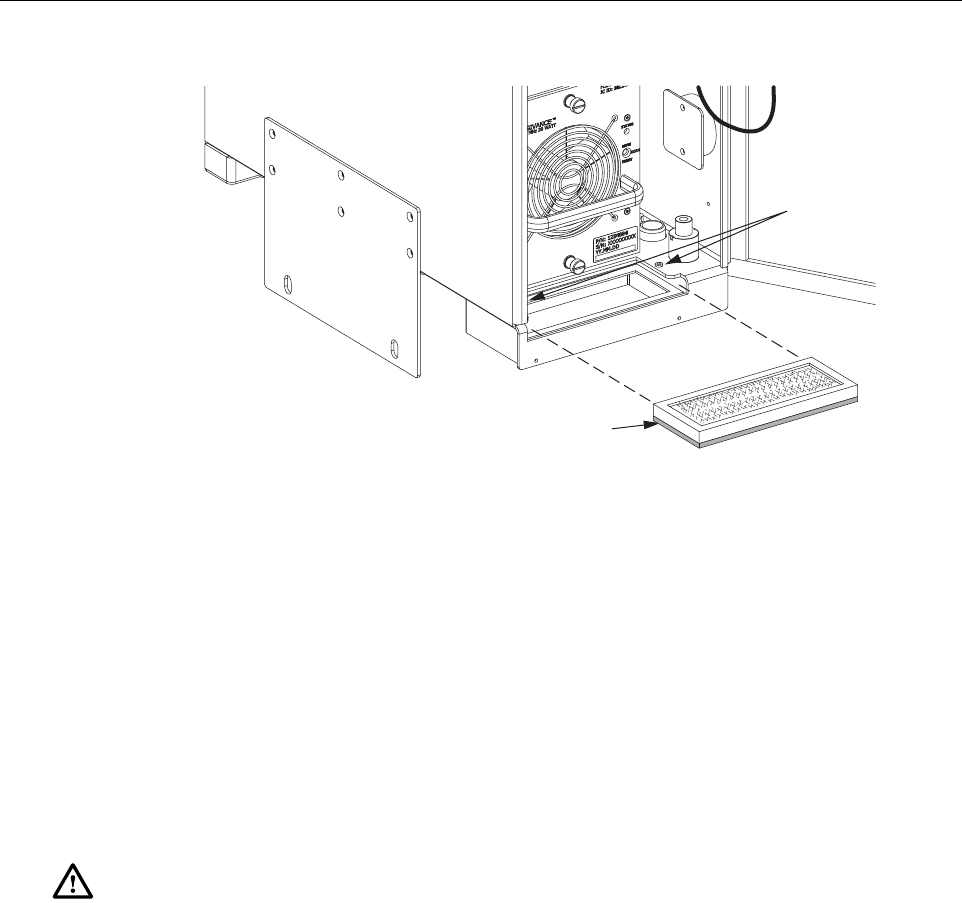
ADCP-75-158 • Issue 1 • July 2003 • Section 5: Maintenance
Page 5-15
© 2003, ADC Telecommunications, Inc.
Figure 5-1. Cabinet Filter Removal and Replacement
5.3 Host Unit Fan Replacement Procedure
The HU is equipped with two cooling fans which are located on the right side of the HU
enclosure. The cooling fans blow cool air into the enclosure. Heated air is exhausted through the
vent openings on the left side of the enclosure. Replacement of the fans requires that the HU be
turned off for a short period of time. Use the following procedure to remove and replace the HU
cooling fans:
1. Before working on the HU or handling a fan, slip on an Electro-Static Discharge (ESD)
wrist strap and connect the ground wire to an earth ground source. Wear the ESD wrist
strap while completing each section of the fan installation procedure.
2. Notify the NOC or alarm monitoring system operator that the system is going offline.
3. Place the HU On/Off switch in the OFF position (press O).
4. Remove the six flat-head screws (requires TORX screwdriver with T10 bit) that secure the
fan/grill assembly to the right side of the HU enclosure as shown in Figure 5-2. Save
screws for reuse.
5. Carefully withdraw the fan/grill assembly from the enclosure until the wiring harness is
exposed and the connectors are accessible.
6. Lift the small latch on each wiring harness connector and carefully unplug each connector
from the circuit board connector.
Warning: Electronic components can be damaged by static electrical discharge. To prevent
ESD damage, always wear an ESD wrist strap when working on the HU, STM, or LPA and
when handling electronic components.
18614-B
FILTER - PLACE FOAM
STRIP SIDE DOWN
SET SCREWS
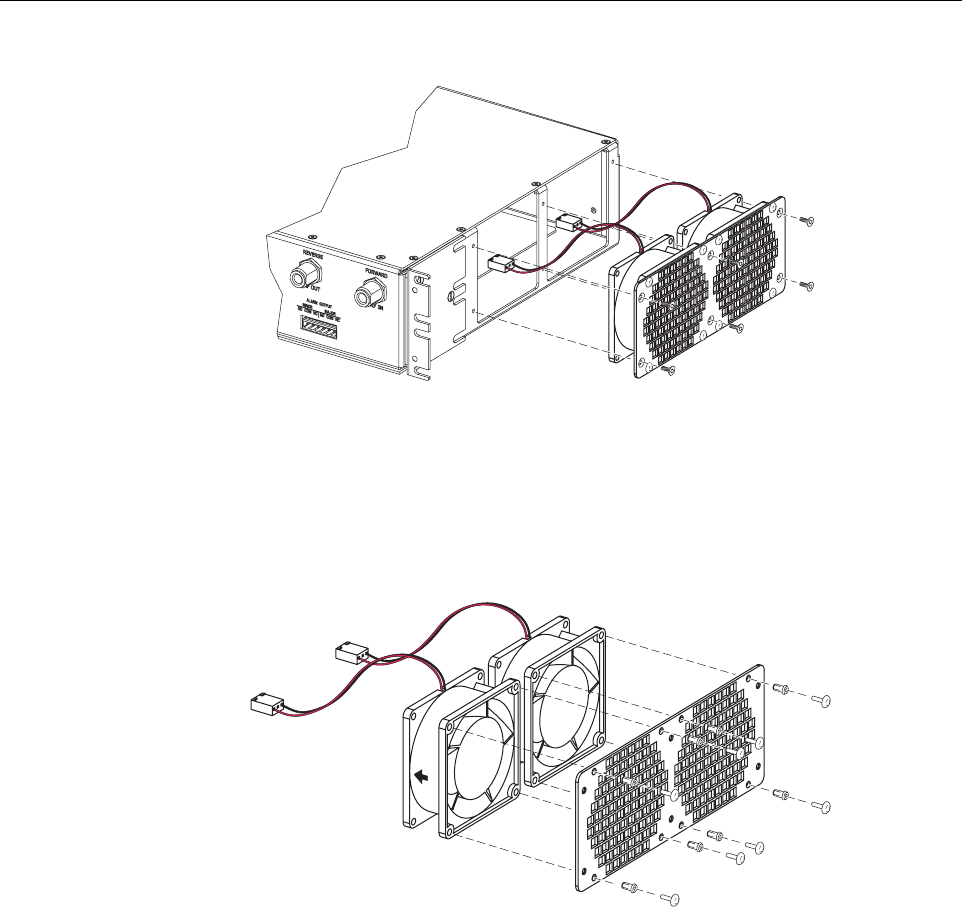
ADCP-75-158 • Issue 1 • July 2003 • Section 5: Maintenance
Page 5-16
© 2003, ADC Telecommunications, Inc.
Figure 5-2. Host Unit Fan/Grill Assembly Removal
7. Remove the plastic rivets that secure each fan to the grill by pushing outward on the rivet
center post until the rivet can be withdrawn from the grill as shown in Figure 5-3.
Figure 5-3. Removing Host Unit Fans From Grill
8. Remove both fans from the grill
9. Use the rivets removed in step 7 to secure the replacement fans to the grill. Orient each fan
so the wiring harness is on the top and the arrow on the fan points into the enclosure.
10. Connect the two wiring harness connectors to the circuit board connectors.
11. Secure the fan/grill assembly to the side of the enclosure (see Figure 5-2) using the six
flat-head screws removed in step 4.
12. Place the HU On/Off switch in the ON position (press I).
13. Verify that the fans run properly following power-up.
14. Notify the NOC or alarm monitoring system operator that the system is going back online.
18615-A
16173-B
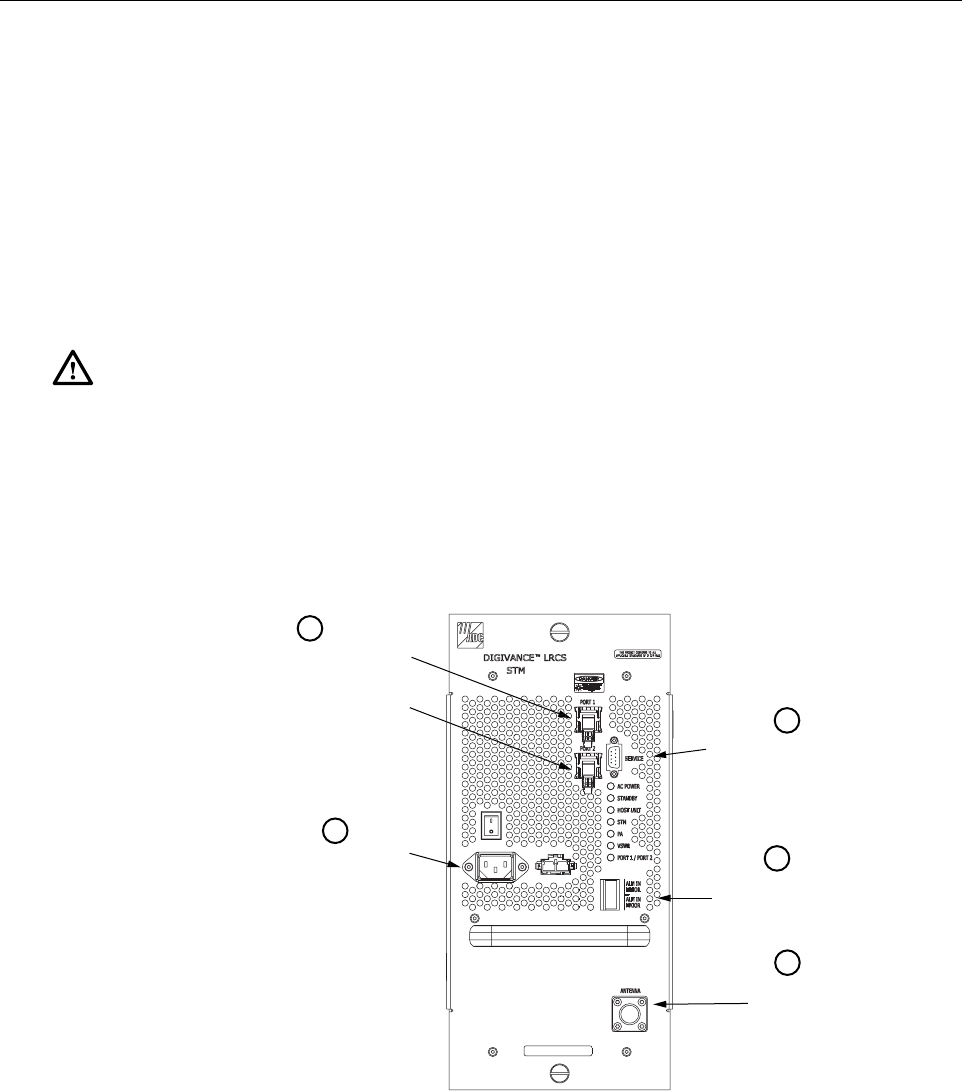
ADCP-75-158 • Issue 1 • July 2003 • Section 5: Maintenance
Page 5-17
© 2003, ADC Telecommunications, Inc.
5.4 Spectrum Transport Module Fan Replacement Procedure
The STM is equipped with a rear-mounted cooling fan. The rear fan exhausts heated air from
the STM housing. Replacement of the fan requires that the STM be turned off for a short period
of time and that the STM be removed from the outdoor cabinet or indoor mounting shelf. Use
the following procedure to remove and replace the STM cooling fan.
1. Before working on the STM or handling a fan, slip on an Electro-Static Discharge (ESD)
wrist strap and connect the ground wire to an earth ground source. Wear the ESD wrist
strap while completing each section of the fan installation procedure.
2. Notify the NOC or alarm monitoring system operator that the system is going offline.
3. Place the STM On/Off switch in the OFF position (press O).
4. Disconnect the various power, fiber optic, service, alarm wiring, and coaxial cable
connectors from the STM front panel as specified in Figure 5-4.
Figure 5-4. Spectrum Transport Module Cable Connections
5. Loosen the captive screws that secure the STM to the RU outdoor cabinet or indoor
mounting shelf and carefully withdraw the STM from its mounting slot.
6. Remove the four pan-head screws (requires TORX screwdriver with T10 bit) that secure
the fan/grill assembly to rear side of the STM housing as shown in Figure 5-5. Save screws
for reuse.
Warning: Electronic components can be damaged by static electrical discharge. To prevent
ESD damage, always wear an ESD wrist strap when working on the HU, STM, or LPA and
when handling electronic components.
18661-A
Disconnect AC
power connector Disconnect alarm
connector
Disconnect antenna
connector
1
2
3
4
5
Disconnect optical fiber
connectors. Place a dust
cap over each cable
connector and port adapter.
Disconnect service
connector (if present)
18661-A
Disconnect AC
power connector Disconnect alarm
connector
Disconnect antenna
connector
1
2
3
4
5
Disconnect optical fiber
connectors. Place a dust
cap over each cable
connector and port adapter.
Disconnect service
connector (if present)
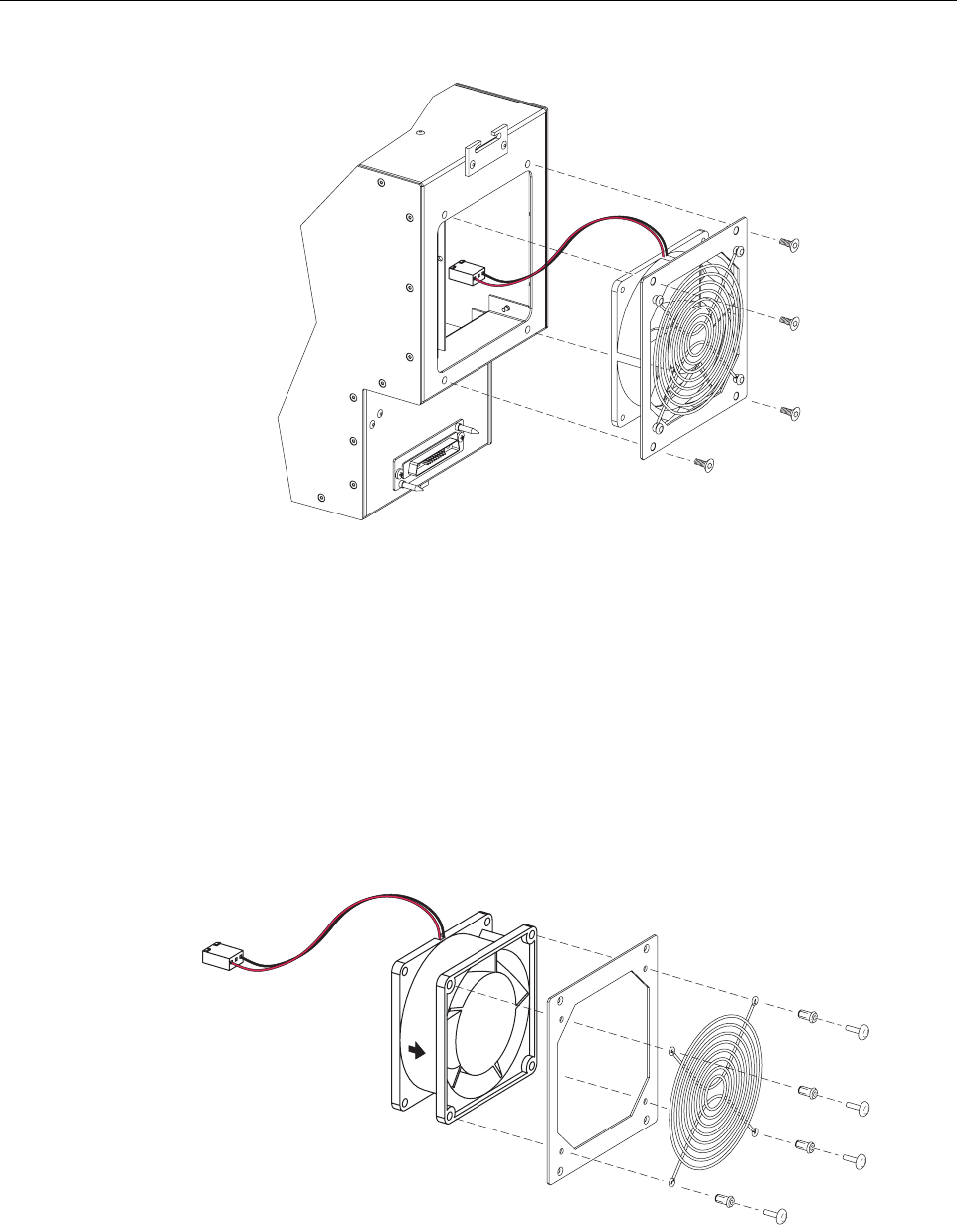
ADCP-75-158 • Issue 1 • July 2003 • Section 5: Maintenance
Page 5-18
© 2003, ADC Telecommunications, Inc.
Figure 5-5. STM Fan/Grill Assembly Removal
7. Carefully withdraw the fan/grill assembly from the STM housing until the wiring harness
is exposed and the connector is accessible.
8. Lift the small latch on the wiring harness connector and carefully unplug the connector
from the circuit board connector.
9. Remove the plastic rivets that secure the fan to the mounting plate and grill by pushing
outward on the rivet center post until the rivet can be withdrawn as shown in Figure 5-6.
10. Separate fan from the mounting plate and grill
Figure 5-6. Removing STM Fan From Mounting Plate and Grill
16992-A
16993-A

ADCP-75-158 • Issue 1 • July 2003 • Section 5: Maintenance
Page 5-19
© 2003, ADC Telecommunications, Inc.
11. Use the rivets removed in step 9 to secure the replacement fan to the mounting plate and
grill. Orient the fan so the wiring harness is on the top and the arrow on the fan points
away from the enclosure. Make certain the rubber grommets are left in place on the
mounting plate.
12. Connect the wiring harness connector to the circuit board connector.
13. Secure the fan/grill assembly to the back of the housing (see Figure 5-5) using the four
pan-head screws removed in step 6. Do not overtighten the screws. The screw threads can
be easily stripped if too much torque is used to tighten the screws.
14. Re-install the STM in the outdoor cabinet or indoor mounting shelf and then re-connect all
cables in the reverse order in which they were disconnected (see Figure 5-4).
15. Place the STM On/Off switch in the ON position (press I).
16. Verify that the fan runs properly following power-up.
17. Notify the NOC or alarm monitoring system operator that the system is going back online.
5.5 Linear Power Amplifier Fan Replacement Procedure
The LPA is equipped with a front-mounted cooling fan. The fan draws cool air into the LPA
housing. Replacement of the fan requires that the STM be turned off for a short period of time
and that the LPA be removed from the outdoor cabinet or indoor mounting shelf. Use the
following procedure to remove and replace the LPA cooling fan.
1. Before working on the LPA or handling a fan, slip on an Electro-Static Discharge (ESD)
wrist strap and connect the ground wire to an earth ground source. Wear the ESD wrist
strap while completing each section of the fan installation procedure.
2. Notify the NOC or alarm monitoring system operator that the system is going offline.
3. Place the STM On/Off switch in the OFF position (press O).
4. Loosen the captive screws that secure the LPA to the RU outdoor cabinet or indoor
mounting shelf and carefully withdraw the LPA from its mounting slot.
5. Remove the four Phillips-head screws that secure the fan/front panel assembly to the front
of the LPA housing as shown in Figure 5-7. Save screws for reuse.
6. Carefully withdraw the fan/front panel assembly from the LPA housing until the wiring
harness is exposed and the connector is accessible.
7. Carefully unplug the fan wiring harness connector from the LPA wiring harness connector.
8. Remove the screws, split-washers, and nuts that secure the fan and grill to the LPA front
panel as shown in Figure 5-8.
9. Separate the fan and grill from the front panel.
Warning: Electronic components can be damaged by static electrical discharge. To prevent
ESD damage, always wear an ESD wrist strap when working on the HU, STM, or LPA and
when handling electronic components.

ADCP-75-158 • Issue 1 • July 2003 • Section 5: Maintenance
Page 5-20
© 2003, ADC Telecommunications, Inc.
Figure 5-7. LPA Fan/Front Panel Assembly Removal
Figure 5-8. Removing LPA Fan From Front Panel
10. Use the screws, split-washers, and nuts removed in step 8 to secure the replacement fan
and grill to the front panel. Orient the fan so the wiring harness is on the right side and the
arrow on the fan points toward the rear of the housing.
11. Connect the fan wiring harness connector to the LPA wiring harness connector.
12. Secure the fan/front panel assembly to the front of the LPA housing using the four
Phillips-head screws removed in step 5. Do not overtighten the screws. The screw threads
can be easily stripped if too much torque is used to tighten the screws.
13. Re-install the LPA in the outdoor cabinet or indoor mounting shelf.
18769-A
PHILLIPS
HEAD SCREW
(4 PLACES)
SPLIT WASHER
AND NUT
(4 PLACES)
ARROW MUST
POINT TOWARD
ENCLOSURE
18768-A

ADCP-75-158 • Issue 1 • July 2003 • Section 5: Maintenance
Page 5-21
© 2003, ADC Telecommunications, Inc.
14. Place the STM On/Off switch in the ON position (press I)
15. Verify that the fan operates properly. The fan should exhaust air from the rear side of the
LPA.
16. Notify the NOC or alarm monitoring system operator that the system is going back online.

ADCP-75-158 • Issue 1 • July 2003 • Section 5: Maintenance
Page 5-22
© 2003, ADC Telecommunications, Inc.
Blank

ADCP-75-158 • Issue 1 • July 2003 • Section 6: General Information
Page 6-1
© 2003, ADC Telecommunications, Inc.
SECTION 6: GENERAL INFORMATION
1 WARRANTY/SOFTWARE . . . . . . . . . . . . . . . . . . . . . . . . . . . . . . . . . . . . . . . . . . . . . . . . . . . . . . . . . . . . . . . . . .6-1
2 SOFTWARE SERVICE AGREEMENT. . . . . . . . . . . . . . . . . . . . . . . . . . . . . . . . . . . . . . . . . . . . . . . . . . . . . . . . . . . 6-1
3 REPAIR/EXCHANGE POLICY . . . . . . . . . . . . . . . . . . . . . . . . . . . . . . . . . . . . . . . . . . . . . . . . . . . . . . . . . . . . . . .6-1
4 REPAIR CHARGES . . . . . . . . . . . . . . . . . . . . . . . . . . . . . . . . . . . . . . . . . . . . . . . . . . . . . . . . . . . . . . . . . . . . . .6-2
5 REPLACEMENT/SPARE PRODUCTS . . . . . . . . . . . . . . . . . . . . . . . . . . . . . . . . . . . . . . . . . . . . . . . . . . . . . . . . . .6-2
6 RETURNED MATERIAL . . . . . . . . . . . . . . . . . . . . . . . . . . . . . . . . . . . . . . . . . . . . . . . . . . . . . . . . . . . . . . . . . . .6-2
7 CUSTOMER INFORMATION AND ASSISTANCE . . . . . . . . . . . . . . . . . . . . . . . . . . . . . . . . . . . . . . . . . . . . . . . . . . .6-3
_________________________________________________________________________________________________________
1 WARRANTY/SOFTWARE
The Product and Software warranty policy and warranty period for all ADC Products is
published in ADC’s Warranty/Software Handbook. Contact the Technical Assistance Center at
1-800-366-3891, extension 73475 (in U.S.A. or Canada) or 952-917-3475 (outside U.S.A. and
Canada) for warranty or software information or for a copy of the Warranty/Software
Handbook.
2 SOFTWARE SERVICE AGREEMENT
ADC software service agreements for some ADC Products are available at a nominal fee.
Contact the Technical Assistance Center at 1-800-366-3891, extension 73475 (in U.S.A. or
Canada) or 952-917-3475 (outside U.S.A. and Canada) for software service agreement
information.
3 REPAIR/EXCHANGE POLICY
All repairs of ADC Products must be done by ADC or an authorized representative. Any
attempt to repair or modify ADC Products without written authorization from ADC voids the
warranty.
If a malfunction cannot be resolved by the normal troubleshooting procedures, call the
Technical Assistance Center at 1-800-366-3891, extension 73475 (in U.S.A. or Canada) or
952-917-3475 (outside U.S.A. and Canada). A telephone consultation can sometimes resolve a
problem without the need to repair or replace the ADC Product.
If, during a telephone consultation, ADC determines the ADC Product needs repair, ADC will
authorize the return of the affected Product for repair and provide a Return Material
Authorization number and complete return shipping instructions. If time is critical, ADC can
arrange to ship the replacement Product immediately. In all cases, the defective Product must be
carefully packaged and returned to ADC.
Content Page

ADCP-75-158 • Issue 1 • July 2003 • Section 6: General Information
Page 6-2
© 2003, ADC Telecommunications, Inc.
4 REPAIR CHARGES
If the defect and the necessary repairs are covered by the warranty, and the applicable warranty
period has not expired, the Buyer’s only payment obligation is to pay the shipping cost to return
the defective Product. ADC will repair or replace the Product at no charge and pay the return
shipping charges.
Otherwise, ADC will charge a percentage of the current Customer Product price for the repair
or NTF (No Trouble Found). If an advance replacement is requested, the full price of a new unit
will be charged initially. Upon receipt of the defective Product, ADC will credit Buyer with 20
percent of full price charged for any Product to be Out-of-Warranty. Products must be returned
within thirty (30) days to be eligible for any advance replacement credit. If repairs necessitate a
visit by an ADC representative, ADC will charge the current price of a field visit plus round trip
transportation charges from Minneapolis to the Buyer’s site.
5 REPLACEMENT/SPARE PRODUCTS
Replacement parts, including, but not limited to, button caps and lenses, lamps, fuses, and patch
cords, are available from ADC on a special order basis. Contact the Technical Assistance Center
at 1-800-366-3891, extension 73475 (in U.S.A. or Canada) or 952-917-3475 (outside U.S.A.
and Canada) for additional information.
Spare Products and accessories can be purchased from ADC. Contact Sales Administration at
1-800-366-3891, extension 73000 (in U.S.A. or Canada) or 1-952-938-8080 (outside U.S.A.
and Canada) for a price quote and to place your order.
6 RETURNED MATERIAL
Contact the ADC Product Return Department at 1-800-366-3891, extension 73748 (in U.S.A. or
Canada) or 952-917-3748 (outside U.S.A. and Canada) to obtain a Return Material
Authorization number prior to returning an ADC Product.
All returned Products must have a Return Material Authorization (RMA) number clearly
marked on the outside of the package. The Return Material Authorization number is valid for 90
days from authorization.
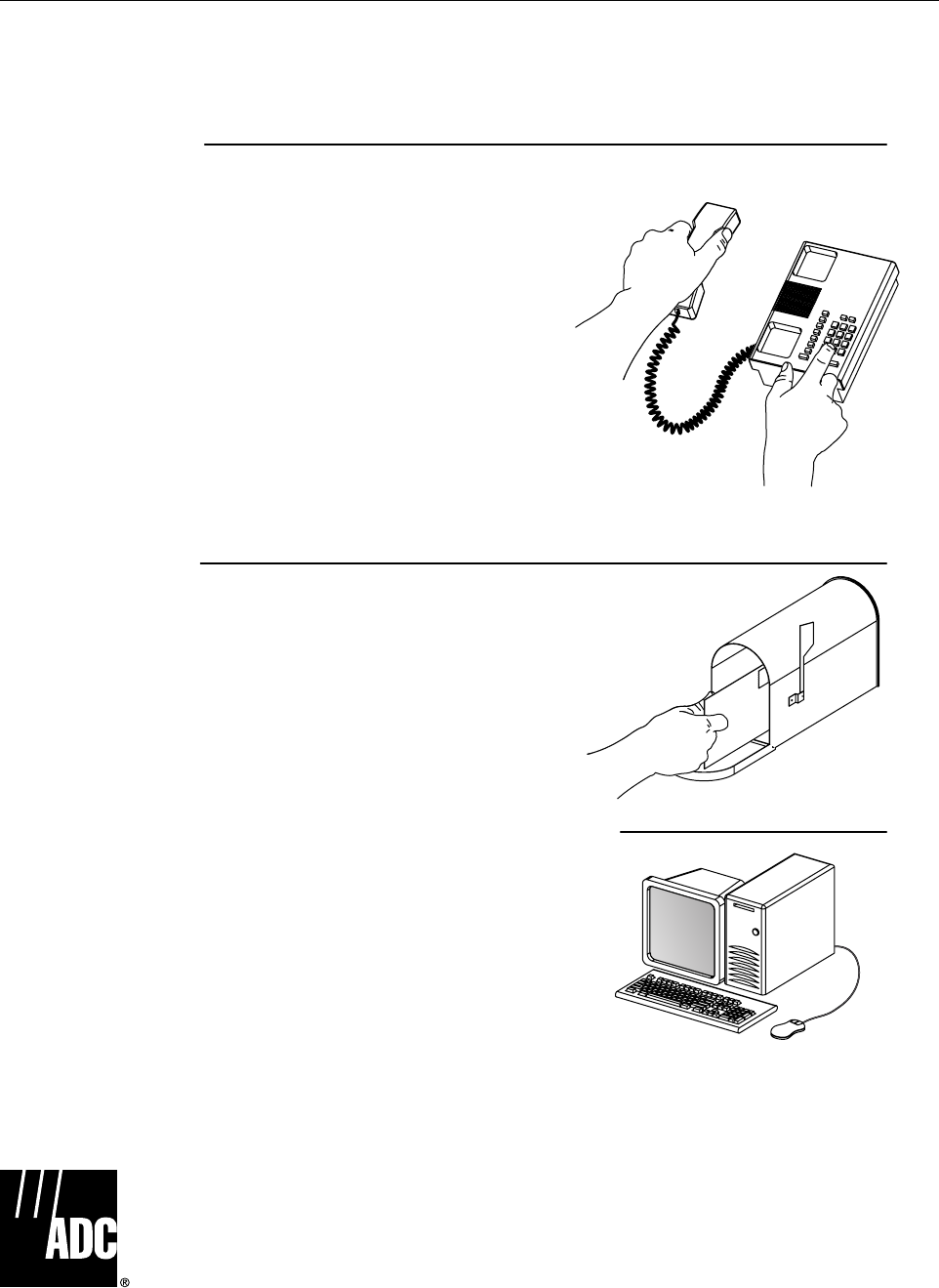
Page 6-3
ADCP-75-158 • Issue 1 • July 2003 • Section 6: General Information
7 CUSTOMER INFORMATION AND ASSISTANCE
© 2003, ADC Telecommunications, Inc.
All Rights Reserved
Printed in U.S.A .
13944-J
WRITE:
ADC TELECOMMUNICATIONS, INC
PO BOX 1101,
MINNEAPOLIS, MN 55440-1101, USA
ADC TELECOMMUNICATIONS (S'PORE) PTE. LTD.
100 BEACH ROAD, #18-01, SHAW TOWERS.
SINGAPORE 189702.
ADC EUROPEAN CUSTOMER SERVICE, INC
BELGICASTRAAT 2,
1930 ZAVENTEM, BELGIUM
PHONE:
EUROPE
Sales Administration: +32-2-712-65 00
Technical Assistance: +32-2-712-65 42
EUROPEAN TOLL FREE NUMBERS
UK: 0800 960236
Spain: 900 983291
France: 0800 914032
Germany: 0180 2232923
U.S.A. OR CANADA
Sales: 1-800-366-3891 Extension 73000
Technical Assistance: 1-800-366-3891 Extension 73475
ASIA/PACIFIC
Sales Administration: +65-6294-9948
Technical Assistance: +65-6393-0739
ELSEWHERE
Sales Administration: +1-952-938-8080
Technical Assistance: +1-952-917-3475
PRODUCT INFORMATION AND TECHNICAL ASSISTANCE:
Contents herein are current as of the date of publication. ADC reserves the right to change the contents without prior notice.
In no event shall ADC be liable for any damages resulting from loss of data, loss of use, or loss of profits and ADC further
disclaims any and all liability for indirect, incidental, special, consequential or other similar damages. This disclaimer of
liability applies to all products, publications and services during and after the warranty period. This publication may be
verified at any time by contacting ADC's Technical Assistance Center.
euro_tac@adc.com
asiapacific_tac@adc.com
connectivity_tac@adc.com

i
www.adc.com